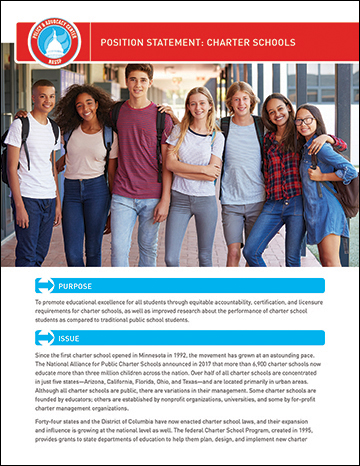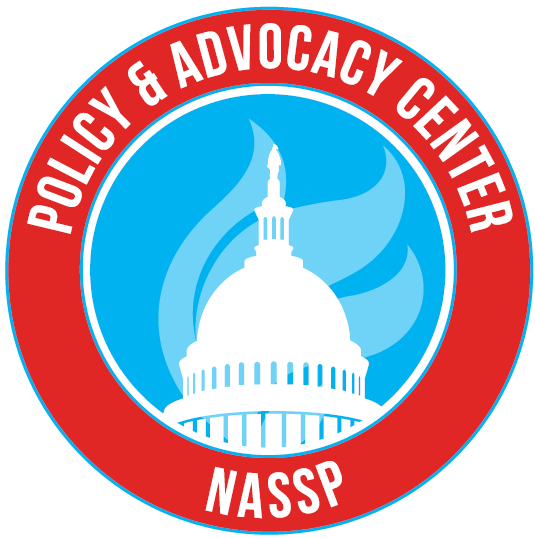To promote educational excellence for all students through equitable accountability, certification, and licensure requirements for charter schools, as well as improved research about the performance of charter school students as compared to traditional public school students.
Since the first charter school opened in Minnesota in 1992, the movement has grown at an astounding pace. The National Alliance for Public Charter Schools announced in 2017 that more than 6,900 charter schools now educate more than three million children across the nation. Over half of all charter schools are concentrated in just five states—Arizona, California, Florida, Ohio, and Texas—and are located primarily in urban areas. Although all charter schools are public, there are variations in their management. Some charter schools are founded by educators; others are established by nonprofit organizations, universities, and some by for-profit charter management organizations.
Forty-four states and the District of Columbia have now enacted charter school laws, and their expansion and influence is growing at the national level as well. The federal Charter School Program, created in 1995, provides grants to state departments of education to help them plan, design, and implement new charter schools, as well as disseminate information about successful charter schools. Support for the Charter School Program continued in 2015 with the passing of the Every Student Succeeds Act (ESSA). ESSA modernizes and improves the program, so that now “a dedicated funding stream will support the replication and expansion of proven charter school models” (Rees, 2015, p. 2). ESSA also provides more flexibility for Title I funds which may benefit charter schools. This includes permitting 5 percent of Title I funds to be used to transport students to schools of their choice, including charters. States may also reserve 3 percent of their Title I funds for “Direct Student Services,” which would include charter schools as well.
Supporters argue that charter schools expand educational opportunities for students and their parents, promote innovation in education, and improve student performance. Skeptics contend that contrary to their mission, charter schools increase racial and ethnic isolation among students; lure away the top-performing students and divert funding from traditional public schools; and demonstrate no real improvements in student achievement. Unfortunately, research on the performance of charter school students in comparison with their traditional public school counterparts is often biased and inconclusive. An article in Science magazine points out that 75 percent of charter school studies were discredited because they “failed to account for differences between the background and academic histories of students attending charter schools and those attending traditional public schools” (Betts & Atkinson, 2012, p. 171). Differences in state charter school laws, school types and the assessments currently used to measure student achievement also make large-scale comparisons difficult.
Supporters also argue that outsourcing a public function to a private entity—often called privatization—lowers costs, increases efficiency, and leads to greater government responsiveness. Indeed, those benefits have been realized in privatizing certain government functions. But the history of education privatization reveals a different story. Tracing the history of school privatization in his book Education and the Commercial Mindset, Samuel Abrams (2017) concludes that education is too complex an endeavor to squeeze into a service contract with sufficient specificity. In addition, the practice of education is not transparent enough to ensure contract compliance. We therefore judge those schools’ performance by the most prominent metrics (usually reading and math scores), which incentivizes a budget-conscious provider to shortchange the consumer on other elements of a well-rounded education.
School Leaders
Charter school principals often transfer the role of instructional leadership to other administrators or teacher leaders, focusing instead on creating and maintaining a mission for their schools, hiring staff, and managing the school’s finances. A study conducted by the National Charter School Research Project at the Center on Reinventing Public Education noted that charter school principals “also have to deal with payroll and facilities management, reporting requirements, and the school’s marketing and student recruitment. In addition, they have to be active advocates for charter schools in local and state policies” (Gross, 2011, p. 13). For these reasons, many charter school authorizers seek leaders with strong organizational management skills but not necessarily prior experience in the classroom. Nonetheless, the study showed that 75 percent of current charter school principals have traditional school administrator training and half of those surveyed for the research study previously worked in traditional public schools.
Another issue of concern for charter schools is that of high principal turnover rate. One study pointed out that charter schools’ “average annual turnover rate is significantly higher than the average” traditional public school (Sun & Ni, 2015, p. 5). Many factors may contribute to this level of higher turnover. Typically, principals with more time teaching and school leadership experience tend to remain in their current position. As noted above, charter principals often have less of this experience than their public school peers and this may contribute to the turnover gap. Another increase in turnover could be the lack of leadership and professional development specifically targeted for charter principals. Although new programs to train charter school leaders are slowly emerging, the demand greatly overwhelms the supply, leaving many with little to no support network to help in their development. The high rate of turnover and the fact that charter schools are often “unable to tap into a pool of ready candidates when hiring” poses a significant problem for retention and hiring of effective charter principals (Campbell, 2010, p. 5).
Guiding Principles
- The mission of NASSP is to promote excellence in middle level and high school leadership through research-based professional development, resources, and advocacy so that every student can be college and career ready.
- NASSP has consistently supported public educational choice for all students as embodied in magnet schools, academies, alternative schools, and schools within schools.
- NASSP believes that charter schools and other nontraditional public schools have the potential to develop innovative methods of educating diverse student populations that can then be replicated in traditional public schools.
- NASSP accepts the concept of charter schools in its broadest sense as an opportunity for all children to learn in ways that best meet their abilities and needs.
Recommendations
Recommendations for Federal Policymakers
- Federal, state, and local policymakers should not divert funding from traditional public schools and should create separate funding streams in order to support charter schools.
- Charter schools accepting public funds should be accountable to the same public agency and held to accountability and oversight requirements equivalent to those mandated for traditional public schools.
- Charter schools should be governed by the same federal and state laws as traditional public schools and held to the same level of accountability as traditional public schools.
- Charter schools should follow federal and state laws regarding educator quality and effectiveness, as well as the licensing and certification of principals and teachers.
- Charter schools that receive public funds should be prohibited from using any enrollment or registration procedures that exclude or discourage any students from enrolling at the school.
- Charter schools must prohibit the use public funds to advance religious or political doctrines that violate constitutional prohibitions.
- The U.S. Department of Education should require that studies on charter schools meet rigorous research and reporting standards.
Recommendations for District Leaders
- Prohibit schools from utilizing enrollment and registration procedures that directly or indirectly exclude or discourage certain students from enrolling at the school (Annenberg Institute for School Reform, 2014).
- Charter schools should be required to meet the same regional accreditation standards as traditional public schools.
- State policymakers should enact strong charter school laws that hold authorizers accountable for school performance and require the closure or restructuring of underperforming charter schools.
- States should support sanctions on authorizers that do not meet professional standards or if schools they oversee continually fail to meet performance standards.
- Charter schools should be held accountable to the same state and district testing and assessment requirements as public institutions. This includes requirements over collecting and making data from said assessments available to the public.
- Research on the performance of charter school students should not focus exclusively on standardized test scores but analyze other outcomes as well, including participation in advanced courses, graduation rates, and college attendance and completion.
- States should ensure that data on the performance of charter school students, especially those participating in admission lotteries, be made available to researchers.
- The performance of charter management organizations should be examined before and after they are allowed to take over a low-performing traditional public school.
- State departments of education should conduct annual assessments on the cumulative impact of charter schools on traditional school districts (Annenberg Institute for School Reform, 2014).
Recommendations for School Leaders
- Establish nondiscriminatory and transparent standards for discipline that are publicly available for all students, parents, and staff. Cooperation between and among all public schools, including charter schools, should be maintained to ensure that innovations stemming from educational choice benefit all students.
- Institutions of higher education and nonprofit leadership organizations should create training and professional development opportunities in regards to charter school leaders.
- Charter school principals should ensure they have succession plans in place and take time to mentor their future replacements and other leadership team members.
Resources
Abrams, S. (2016). Education and the commercial mindset. Cambridge, MA: Harvard University Press.
Annenberg Institute for School Reform. (2014). Public accountability for charter schools. 2014, pp. 3–12.
Baker, B. Punswick, E., & Belt, C. (2010). School leadership stability, principal moves, and departures: Evidence from Missouri. Educational Administration Quarterly, 46(4), 523–555.
Betts, J. R., & Atkinson R. C. (2012). Better research needed on the impact of charter schools. Science, 171–172.
Campbell, C. & Gross, B. (2008). Working without a safety net; How charter school leaders can best survive on the high wire. Seattle, WA: Center on Reinventing Public Education.
Campbell, C. (2010). You’re leaving? Success and sustainability in charter schools. Seattle, WA: Center on Reinventing Public Education.
Di Carlo, M. D. (2011). The evidence on charter schools and test scores [Blog post]. Retrieved from http://shankerblog.org/wp-content/uploads/2011/12/CharterReview.pdf
Finn, Chester, & Brandon Wright. Why it’s hard to grasp charter school effectiveness. The Thomas B. Fordham Institute, Retrieved from http://edexcellence.net/articles/why-its-hard-to-grasp-charter-school-effectiveness
Gross, B. (2011). Inside charter schools. Seattle, WA: Center on Reinventing Public Education.
National Alliance for Public Charter Schools. (2017). Estimated charter public school enrollment, 2016–17. Retrieved from http://publiccharters.org/publications/estimated-charter-public-school-enrollment-2016-17/
National Alliance for Public Charter Schools. (2017). 2016 annual report. pp. 4–5.
National Association of Charter School Authorizers. (2016). On the road to great charter schools: State policy analysis, 2016. Retrieved from http://www.qualitycharters.org/policy-research/state-policy-agenda/2016-spa-report/
Protheroe, N. (2011). Concerns in education: what do we know about charter schools? Alexandria, VA: Educational Research Service.
Rees, Nina. (2015, December 15). Charter schools bring parties together. U.S. News & World Report. Retrieved from http://www.usnews.com/opinion/knowledge-bank/articles/2015-12-15/every-student-succeeds-act-reflects-bipartisan-support-for-charter-schools. Accessed 29 Aug. 2017
Secret, Mosi. The Way to Survive It Was to Make A’s. The New York Times. Retrieved from http://www.nytimes.com/2017/09/07/magazine/the-way-to-survive-it-was-to-make-as.html
Sun, M., & Yongmei N. (2015). Work environments and labor markets: Explaining principal turnover gap between charter schools and traditional public schools. Educational Administration Quarterly, Volume 52 (1), 144-183.


